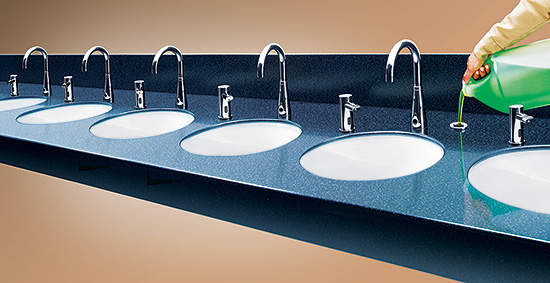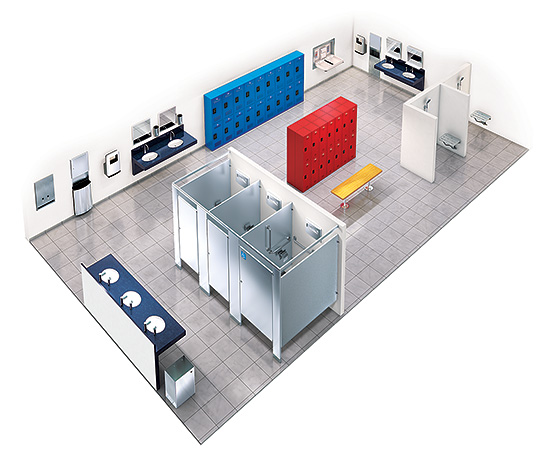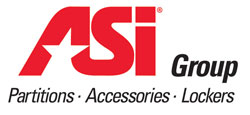Taking Sustainable Washroom Design Beyond LEED
The 2010 ADA Standards Have New Implications for Design in Washrooms
The 2010 Americans with Disabilities Act (ADA) Standards for Accessible Design have added some new requirements for toilet partitions. Designing accessible partition systems requires extra care with regard to dimensions and fixture locations. In particular, the 2010 ADA Standards have clarified the sizes of accessible stalls and what can go in them. Implications include dimension requirements, door standards, and hardware specifications. These, in turn, influence materials and planning layout. At least one toilet compartment must be wheelchair accessible in all multi-user restrooms.
Accessible washrooms also must be located on an accessible route and have compliant doors, so that people with disabilities, including those in wheelchairs, can enter the space. Required clearances must provide sufficient room to enter, turn around, and close and lock the door. Door maneuvering clearances need to provide room to approach and open doors and to exit the space. The maneuvering clearance required at doors is configured according to swing and approach. Some overlap of other clearances, such as water closet and lavatory, is allowed, depending on locations of the elements.
Furthermore, turning space is required within the stall. Turning space must be either a 60-inch circle or T-Shaped. Doors may not swing into turn space under any condition. Rooms with doors that swing out require less space, but a strike side clearance may be required on the push side. Where doors swing out, this may further determine the space requirements.

Photo courtesy of The ASI Group
By selecting accessories during the design phase, ease of management and maintenance can be integrated into the washroom.
The clear floor space requirements at water closets accommodate a variety of transfers from a wheelchair, including side transfers, which enables disabled users to have several options, depending on preference and ability. Grab bars located on the side and rear walls are critical for transfer. Flush controls must be located on the open side of the water closet. Clearances also are required at other elements, including soap dispensers, towel dispenser, and hand dryers. Likewise, faucet controls and other operable parts are governed by the 2010 Standards. The size of single user washrooms is determined by room layout, configuration of fixtures, and the swing of doors.
The compartment opening is offset from the water closet to provide space for entry and transfer. Toe clearance below one side partition and front partition provides additional maneuvering space. An additional accessible compartment is required where 6 or more compartments exist.
A 30-inch x 48-inch CLFS (clear floor space) is mandated at every fixture, accessory, and operable piece of hardware. Clear Floor Space for a sink can go all the way under the sink to the wall if there is clearance. The Clear Floor Space for accessories and sinks must adjoin the Path of Travel (POT). Generally speaking, door swings may not impinge on CLFS.
The 2010 ADA Standards have specific requirements for accessible hardware, including grab bars—both location and reinforcement, door latches, and door pulls.
Specific standards include:
• 604.8.1.2 Doors: The stall door must be on the opposite wall / diagonal from the water closet and within 4 inches maximum from the stall corner. Clear floor space, toe clearance at doors and partitions, and accessible urinals and screens are governed by this provision.
• 309.4 Operation: Operable parts shall be operable with one hand and shall not require tight grasping, pinching, or twisting of the wrist. The force required to activate operable parts shall be no greater than 5 pounds maximum.
• 404.2.7 Door and Gate Hardware: Handles, pulls, latches, locks, and other operable parts on doors and gates shall comply with 309.4. Operable parts of such hardware shall be 34 inches minimum and 48 inches maximum above the finish floor or ground.
Realizing a Sustainable Washroom that Lasts Through Time Takes a Marriage of Thoughtful Design and Maintenance
Washrooms can be memorable, for all the right, or wrong reasons. Frequently, they are the lynchpin that leaves a lasting impression—good or bad—on a client or customer, and color his or her assessment of a business or venue. For that reason, it is unfortunate that public washrooms are all too often relegated to the level of an undesirable necessity through poor material selection and lack of maintenance exacerbated by poor planning. Products that are well integrated, that work together, allow fulfillment from an aesthetic sense in addition to meeting the need for functionality.
Products and design that work well together result in sustainability. A great washroom exemplifies true sustainability. Reaching beyond just the certification affixed to its plaque, or the standards adhered to by its products, a sustainable washroom has a design professional behind it who thoughtfully planned a maintainable, durable design with an eye toward initial and total lifecycle cost and pleasing aesthetics. This forward thinking helps guarantee the longest possible lifecycle of use for each component in the design: from partition material, to assembly construction, to individual hardware and accessories.
Considering the lifecycle of the product means making a selection so that product doesn’t end up in a landfill. Use of appropriate materials is a significant part of developing a sustainable installation. Designing for maintainability over the life of a project is a key aspect of lifecycle cost. Despite everything we know about designing to first costs, we still find ourselves seeking to minimize the initial material costs. Having an excellent working relationship with manufacturers and suppliers offering multiple options allows a designer to have access to the very best selection for the unique project.

Photo courtesy of The ASI Group
By understanding the full range of material and product options available, a designer can select the best strategy to thorough up-keep and user accommodation, securing a sustainable, attractive washroom.
You wouldn’t wear a raincoat to go scuba diving any more than you would wear scuba gear to keep out the rain, but it is good to be able to have a choice in what you wear for different occasions.
Similarly, having a choice in washroom partitions, washroom accessories and lockers in a facility allows for a premium selection that maximizes aesthetic and durability benefits in place. Choice also means the potential to utilize more than one type of material, if applicable, in a design. Don’t be afraid to use manufacturers as reference points in both installation and care. Design professionals must become familiar with maintenance procedures and materials if they are to protect their designs and create truly sustainable projects. Maintenance should be first not last. Most product installation manuals have some minimum discussion about maintenance and use of cleaning products. Cleaning maintenance and system maintenance must be understood and communicated to the owner. This ensures that materials will not suffer from corrosion in harsh or chemical environments that greatly shorten partition life.
Maintainability. Design sensibility. Sustainability. Having a complimentary relationship between these elements: partition material, assembly type, and hardware selection, means reinforcing the durability of each. Couple that with a design that anticipates maintenance and user needs, and the design professional has the recipe for washroom sustainability.
Amanda Voss, MPP, is an author, editor, and policy analyst based in Colorado. She serves as the managing editor for Energy Design Update, has taught multiple live AIA CEU classes, and served on the board of Energy Literacy Advocates. She has a background in residential construction and custom building.
 |
The ASI Group, comprised of American Specialties, Inc., ASI Global Partitions, ASI Accurate Partitions, and ASI Storage Solutions, offers a single-source solution for washroom accessories, toilet partitions, lockers, and other storage products. www.asigroup.us |








